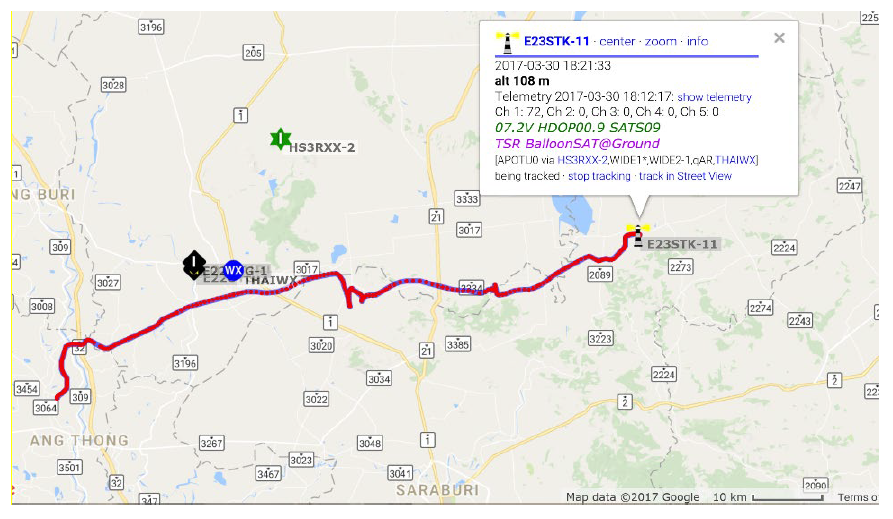Development of High-Altitude Balloon Platform for Education, Experiment and Research in Science, Technology and Engineering
Keywords:
high-altitude balloons, autonomous tracking, mission operation, parachute, CubeSatAbstract
This paper presents a study and development of high-altitude balloon platform for education, experiment and research in science, technology and engineering where it is necessaryto conduct the experiments in the atmosphere above stratosphere. Moreover, the high distance can also be used to simulate near space conditions, used in experiments or measurements of various physicalquantities in high-level atmospheric physics includinguse in the measurement for meteorology. The platform consists of 2 major parts: 1) Calculations involving balloon for mission planning such as ability to carry payloads for testing, lifting force, total time the balloon can stay afloat for the mission, ascent rate, etc. It also includes designing a parachute for bringing all payloadsback to Earth after complete a mission. 2) Balloon coordinate tracking system and communication system which serves to transmit coordinates for tracking and other necessary measurement data to the ground. This is to keep track of the balloon’s travel position during the mission, including the vertical displacement and the horizontal displacement caused by wind current/direction, and also used to track the last stop for recoverymission. The main contribution and relevant knowledge for the mission that use high-altitude balloon platform for testing will be explained in this paper. Along with conducting some experiments on the use of a high-altitude balloon platform to test engineering prototype of the 1U CubeSat (KMITL-CubeSat), we can visualize its application to the KMITL-CubeSat and also apply to other tests in the work and mission of science, technology and engineering in other areas further.References
Chaisita, T., Nakorn, T. N., Prathetrat, C., Sutthikarn, P., Chivapreecha, S., & Trirat, A. (2020). Development of High-Altitude Balloon Tracking by APRS System. ECTI CARD 2020,Nakornsawan, Thailand. (in Thai)
Cross, R. (2007). Aerodynamics of a Party Balloon. The Physics Teacher, 45(6), 334-336. https://doi.org/10.1119/1.2768686
Gallice, A., Wienhold, F. G., Hoyle, C. R., Immler, F., & Peter, T. (2011). Modeling the ascent of sounding balloons: derivation of the vertical air motion. Atmos. Meas. Tech., 4(10), 2235-2253. https://doi.org/10.5194/amt-4-2235-2011
Kerry, T. N., Kim, M. A., Matthew, K. H., & Alexey, A. P. (2007). Aerodynamic and Mission Performance of a Winged Balloon Guidance System. Journal of Aircraft, 44(6), 1923-1 9 3 8 . https://arc.aiaa.org/doi/abs/10.2514/1.31922
Kusonthammarat, T., Thepsittha, T., & Sutthikarn, P. (2016). Design and Implementation of CubeSat Engineering Model and Channel Coding Department of Telecommunications Engineering.Faculty of Engineer, King Mongkut’s Institute of Technology Ladkrabnag. (in Thai)
McKaig, J., Caro, T., Hyer, A., Talburt, E. D., Verma, S., Cui, K., Boguraev, A.-S., Heit, M., Johnson, A., Johnson, E., Jong, A., Shepard, B., Stankiewiz, J., Tran, N., & Rask, J. (2019). A High-Altitude Balloon Platform for Space Life Sciences Education. Gravitational and Space Research, 7(1), 62-6 9 . https://doi.org/10.2478/gsr-2019-0007
Roeksukrungrueang, C. (2016). The CubeSat Engineering Model and Improvement of Power Consumption using Adjustable Code Rate Convolution Code Department of Telecommunications Engineering.Faculty of Engineer, King Mongkut’s Institute of Technology Ladkrabnag. (in Thai)
Safonova, M., Nayak, A., Sreejith, A. G., Mathew, J., Sarpotdar, M., Ambily, S., Nirmal, K., Talnikar, S., Hadigal, S., & Prakash, A. (2015). An overview of high-altitude balloon experiments at the Indian Institute of Astrophysics. Astronomical and Astrophysical Transactions, 29(3), 397-426. https://doi.org/10.48550/arXiv.1506.01538
Shane, L. L., John, C. A., & William, A. H. (2009). The first frontier: High altitude ballooning as a platform for student research experiences in science and engineering. American Journal of Physics, 77(6), 489-497. https://aapt.scitation.org/doi/abs/10.1119/1.3097775
Sitha, W., Sutthikarn, P., & Chivapreecha, S. (2020). Simulation Software Development for Mission Planning of Science/Engineering Testing Using with High-Altitude Balloon. ARUCON2020, Ayutthaya, Thailand.
Smith, T. P. (2 0 1 2 ) . Balloon Calculations.https://northstar-www.dartmouth.edu/~klynch/pmwikigc/uploads/BalloonCalulations.pdf
Sutthikarn, P., Chivapreecha, S., Sitha, W., Jongsataporn, T., & Trirat, A. (2020). Automatic Position Reporting System for Miniaturized Satellite Experiment Using High-Altitude Balloon. 2020International STEM Education Conference (iSTEM-Ed 2020), Huahin, Thailand.
Techavijit, P. (2020). Practical Ground-Space Communication Network for Miniaturized Satellites Department of Electrical Engineering.Faculty of Engineer, King Mongkut’s Institute of Technology Ladkrabnag. (in Thai)
Techavijit, P., Chivapreecha, S., Sukchalerm, P., & Wongphuangfuthaworn, N. (2016). Suitable altitude for long-operated communication high altitude balloon with experimental flights. 2016-8th International Conference on Knowledge and Smart Technology (KST), Chiangmai, Thailand.
Techavijit, P., Chivapreecha, S., Sukchalerm, P., & Plodpai, A. (2016). CubeSat image transmission in JPEG compression: An experiment on high altitude platform[Paper presentation]. the 2016-8th International Conference on Knowledge and Smart Technology (KST).
Techavijit, P., Sukchalerm, P., Wongphuangfuthaworn, N., Plodpai, A., Manuthasna, S., & Chivapreecha, S. (2018). Internet Network in Space for Small Satellites: Concept and Experiments. Sensors and Materials, 30(10), 2295-2311. https://doi.org/10.18494/SAM.2018.1854
Thaheer, A. S. M., & Ismail, N. A. (2017). Mission design and analysis of USM high-altitude balloon. Journal of Mechanical Engineering (JMechE), 14(2), 62-92.

Downloads
Published
Issue
Section
Categories
License
Copyright (c) 2023 Journal of Applied Science and Emerging Technology

This work is licensed under a Creative Commons Attribution-NonCommercial-NoDerivatives 4.0 International License.

